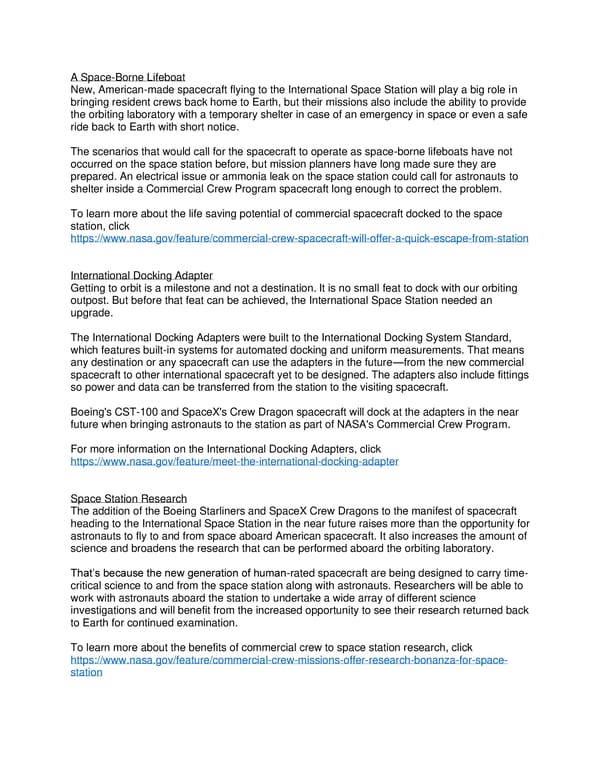A Space-Borne Lifeboat New, American-made spacecraft flying to the International Space Station will play a big role in bringing resident crews back home to Earth, but their missions also include the ability to provide the orbiting laboratory with a temporary shelter in case of an emergency in space or even a safe ride back to Earth with short notice. The scenarios that would call for the spacecraft to operate as space-borne lifeboats have not occurred on the space station before, but mission planners have long made sure they are prepared. An electrical issue or ammonia leak on the space station could call for astronauts to shelter inside a Commercial Crew Program spacecraft long enough to correct the problem. To learn more about the life saving potential of commercial spacecraft docked to the space station, click https://www.nasa.gov/feature/commercial-crew-spacecraft-will-offer-a-quick-escape-from-station International Docking Adapter Getting to orbit is a milestone and not a destination. It is no small feat to dock with our orbiting outpost. But before that feat can be achieved, the International Space Station needed an upgrade. The International Docking Adapters were built to the International Docking System Standard, which features built-in systems for automated docking and uniform measurements. That means any destination or any spacecraft can use the adapters in the future—from the new commercial spacecraft to other international spacecraft yet to be designed. The adapters also include fittings so power and data can be transferred from the station to the visiting spacecraft. Boeing's CST-100 and SpaceX's Crew Dragon spacecraft will dock at the adapters in the near future when bringing astronauts to the station as part of NASA's Commercial Crew Program. For more information on the International Docking Adapters, click https://www.nasa.gov/feature/meet-the-international-docking-adapter Space Station Research The addition of the Boeing Starliners and SpaceX Crew Dragons to the manifest of spacecraft heading to the International Space Station in the near future raises more than the opportunity for astronauts to fly to and from space aboard American spacecraft. It also increases the amount of science and broadens the research that can be performed aboard the orbiting laboratory. That’s because the new generation of human-rated spacecraft are being designed to carry time- critical science to and from the space station along with astronauts. Researchers will be able to work with astronauts aboard the station to undertake a wide array of different science investigations and will benefit from the increased opportunity to see their research returned back to Earth for continued examination. To learn more about the benefits of commercial crew to space station research, click https://www.nasa.gov/feature/commercial-crew-missions-offer-research-bonanza-for-space- station
 NASA, SpaceX & Boeing | Commercial Crew Program Page 31 Page 33
NASA, SpaceX & Boeing | Commercial Crew Program Page 31 Page 33